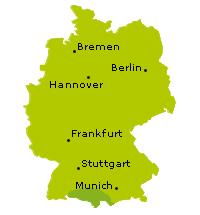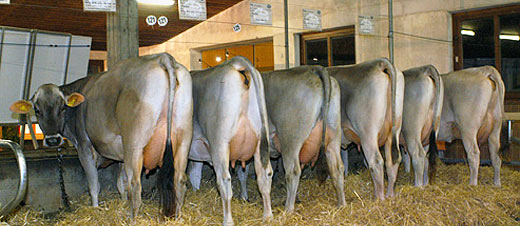
German Braunvieh (Brown Swiss)
Advantages of German Brown Swiss:
- good-natured dual purpose cattle
- 8.000 to 9.000 kg milk with 7% to 8% protein and fat content
- high-quality milk with an excellent taste and cheese making capability (Cappa Casein B)
- adapts ideal to different housing areas and withstands tropical heat just as to extreme coldness without any difficulties
- strong legs with outstanding hard hooves ensures the longevity, which is proverbial for German Brown Swiss
- excellent udder health and shape with best milkability
The guarantee for economical milk production!
| Facts & Figures: | 2011 |
| population in total: | ~ 455.000 |
| cows in herdbook: | 147.694 |
| Ø milk production (kgs/lactation): | 7.168 |
| Ø fat content (%): | 4,16 |
| Ø protein content (%): | 3,55 |
| daily gains of bulls (g/day): | > 1.250 |
| slaughter result (% of liveweight): |
> 57 |
| bone-meat relation: | 1 : 4,88 |
| calving interval (days): | 415 |
| first calving age (months): | 30,7 |
| Ø culling age (years): | > 6,3 |

6% of all herdbook cattle in Germany
The German Brown Swiss breed is the ideal choice for medium sized farms in all climatic conditions with the main goal of a profitable milk production!
 The German Brown Swiss is most commonly found in the rough mountainous Alp region and grassland foodhills in the southwest of Germany.
The German Brown Swiss is most commonly found in the rough mountainous Alp region and grassland foodhills in the southwest of Germany.
This area is a traditional dairy production area and is also called the cheese dairy of Germany.
The first breeder association was founded in Sonthofen in Bavaria in 1879. German Brown Swiss therefore, has one of the oldest herdbook traditions in Germany.
Through the strongly organized, innovative breeding programme, the consequent, exact selection as well as application of modern biotechniques, German Brown Swiss reach the highest possible breeding progress.
As INTERBOVES in Altusried is located in the heart of the German Brown Swiss region, the selection of your cattle will take place in front of our office door. Each selection will be accompanied by an expert of the herdbook association, where our own dairy farm is a member since 1968.
The rearing conditions in the area of distribution of the German Brown Swiss are more varied than almost anywhere else. They range from pastures in the harsh high alpine locations with meagre basic feed all the way to year round free stall or confined rearing with nutritious feed in intensively utilised arable areas. German Brown Swiss achieve the best possible performance for many years at all these conditions because of their adaptability, robustness and excellent limbs.

German Brown Swiss is known and very sought-after world-wide as a very robust and adaptable top performance breed. German Brown Swiss cows produce, having no close competitors, their performance under the most extreme conditions, from tropical heat to the harshest high mountain climates with meagre feed. They acclimate themselves to all sorts of rearing conditions. German Browns Swiss can develop their enormous potential under perfect conditions. The longevity of German Browns Swiss is exceptional, a very positive factor if considering the economicalness.
Good milk performance has always been a most important factor for German Brown Swiss breeding. The basic economical conditions continue to require increasing emphasis on high milk performance. It is for this reason that an even higher value was laid there on by the latest determination of the breeding aims for German Brown Swiss. The average cow is bred to give from 8.000 to 9.000 kg of milk per year. Importance is attached to achieving a flat curve for lactation and a good increase in later lactation performance.
The contents of the milk of the German Browns Swiss as well as the amount are given special consideration. The breeding aim is to achieve at least 7% to 8% fat and protein content in the best protein-fat ratio. The performance for protein content is given the highest priority. This performance should surpass 300 kg per year with good quality feed.
For economic reasons good beef performance is the second most important production factor for the German Browns Swiss breed. Male calves raised in bull fattening farms proved to be extremely economical and achieved daily weight gains of over 1.250 grams with good slaughtering shape. Accordingly, they are competitive with other breeds used, especially for beef production.
Crossings for the specialists: Blonde d´Aquitaine and Belgium-Blue as paternal breed are proven with regard to the capability of fattening as well as that of beef quality. The gains, the slaughter-out-percentage and the vitality of the animals are superior to other specialized beef breeds.

 our livestock
our livestock